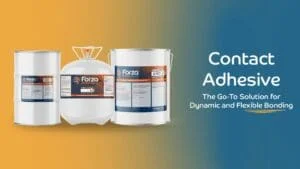What Are Contact Adhesives, and How do They Work?
Contact adhesives (aka contact cement), are adhesives that bond on contact with a substrate. The adhesive is applied to both substrates, and then mated together using pressure to form a strong, permanent bond.
What are the difference between contact adhesives and PSA’s? You can learn more on this blog about pressure sensitive vs contact adhesives, but basically PSA’s remain tacky once dry and will stick to most anything, whereas contact adhesives stick to themselves once dry (hence the need to coat both substrates with adhesive), taking along with themselves the substrates they’re stuck to.
Once the substrates have been bonded, there’s no need to wait for the adhesive to cure, as contact adhesives bond instantly. This is why contact adhesives are so good for permanent applications, as once they stick, they’re stuck! There’s no room for error with these adhesives, so positioning and planning are key to a successful bond.
There are both water-based and solvent-based contact adhesives. Solvent-based contact adhesives dry quicker, allowing the substrates to be bonded sooner. Water-based contact adhesives take longer to dry, but the drying time can be shortened by heat or increased air movement. Solvent-based contact adhesives do release the solvent in the air as they dry, but are typically more tolerant of surface contamination and are much less finicky than water-based contact adhesives.
What is the solids percentage of a contact adhesive?
You can learn more in this blog about solids content, but it’s the solid portion of the adhesive, which is the bonding agent. Adhesives with a higher solids percentage generally contain more usable adhesive per unit.
Contact adhesives bond a wide variety of substrates such as wood, leather, metal and laminates, and are especially good for non-porous substrates. The high initial strength of these adhesives makes them ideal for laminating applications. They are ideal for large surface areas or applications when it is awkward to clamp, and are used for many other applications such as countertops, furniture, and building or recreation vehicle side panels.
Typically, contact adhesives come in a pail, drum or other container, and use the brush, roller or spray delivery methods. They are also available in a pressurized canister system, which is an efficient, portable and time-saving delivery system.
As with applying any type of adhesive, it is critical to apply the correct amount of adhesive. Too much or too little adhesive will result in a weak bond. The substrates being bonded may need two coats, especially if they are porous.
One way to tell if there’s not enough adhesive, is if there’s any areas where the adhesive is that look a bit dull. The best way to ensure you have the proper amount of coverage is by following the product label directions, and using the correct tools for the job. Bear in mind that with contact adhesives, the substrates will bond immediately on contact, so it is critical to get the positioning correct as you won’t be able to re-position the substrates later.
Contact adhesives must be allowed to dry before assembly. They dry through evaporation and are quick to dry, and if a quicker drying time is needed, fans or heat will speed up the process. Drying time is affected by temperature and humidity – it is faster at higher temperatures and lower humidity, and slower at lower temperatures and higher humidity. The thickness of the adhesive will also affect the drying time.
Once the adhesive is dry, you will have a certain window of time, the open time, in which the bond must be made. To check if the adhesive is dry enough to bond, take the back of your hand and use your knuckles to press against the adhesive. Do not use the inside of your hand, as the oils from your hand could transfer to the surface of the adhesive, which could result in a weak bond. If no adhesive transfers to your knuckles, the adhesive is dry and ready to bond!
Once the bond has been made, pressure is needed to ensure the bond is successful. A standard J roller or a pinch roller may be used to apply pressure.
Do you have an application where you think a contact adhesive could be used? Contact us, and let us know your application and the substrates you’re bonding – we would love to point you towards the right adhesive for the job!




